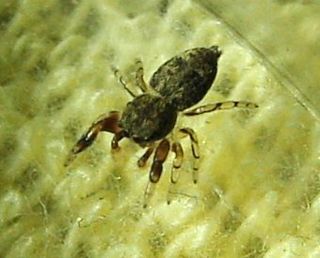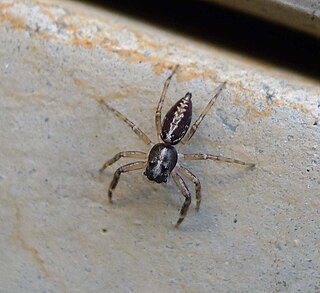
Agorius is a genus of spiders in the family Salticidae. The genera Agorius and Synagelides are separated as a genus group, sometimes called subfamily Agoriinae but more recently downranked to tribe Agoriini of the Salticoida clade in subfamily Salticinae.
Anarrhotus is a genus of jumping spiders. The only described species Anarrhotus fossulatus is endemic to Malaysia. It is one of several monotypic genera from Southeast Asia where, despite their first description dating back more than a hundred years, there are no habitat details, although genital and sometimes other drawings are now available for several of them. Anarrhotus is only known from a single male specimen, the pedipalp of which was drawn by Proszynski (1984). The original describer Eugène Simon put the genus close to Pancorius. The male is 6 mm long.

Ballus is a spider genus of the family Salticidae.

Canama is a genus of spiders in the jumping spider family, Salticidae. Its five described species occur from Borneo to Queensland.
Cheliceroides longipalpis is a species of spider in the family Salticidae, found in China and Vietnam.

Epeus is a genus of the spider family Salticidae. They are often found on broad-leaved plants or shrubs of rain forest, or in gardens of Southeast Asia.
Erasinus is a genus of the spider family Salticidae.
Eupoa is a genus of spiders in the family Salticidae. Originally known only from one species from Vietnam, several other species have been described since 1997, all from China.
Gambaquezonia is a genus of the spider family Salticidae with two species. It was first described in some detail by Barrion & Litsinger (1995) from the female holotype, the only known specimen at the time. Its general appearance was later redescribed by Murphy and Murphy (2000).
Idastrandia is a genus of jumping spiders endemic to Singapore. Its only described species is Idastrandia orientalis.
Lepidemathis is a spider genus of the jumping spider family, Salticidae. The four described species are endemic to the Philippines.
Ligdus is a genus of jumping spiders found in Burma. It contains only one species, Ligdus chelifer.
Ligonipes is a spider genus of the jumping spider family, Salticidae. Five of the six described species are found in the Australian region, the exception being Ligonipes similis, recorded as being from Sumatra. Their body form mimics ants.
Magyarus is a monotypic genus of Vietnamese jumping spiders containing the single species, Magyarus typicus. It was first described by Marek Michał Żabka in 1985, and is only found in Vietnam.
Nungia is a monotypic genus of Asian jumping spiders containing the single species, Nungia epigynalis. It was first described by Marek Michał Żabka in 1985 from a single 6 millimetres (0.24 in) long female, although males have later been found. The name is derived from the Nùng people of Vietnam and China. The species name is derived from "epigyne".
Paracyrba is a genus of jumping spiders found only in Malaysia. It contains only one species, Paracyrba wanlessi. Its microhabitat are the water-filled hollow internodes of decaying bamboo, where it preys for aquatic animals, especially mosquito larvae. P. wanlessi and Evarcha culicivora, a jumping spider, are the only two spiders that have been experimentally studied and considered a mosquito specialist. E. culicivora indirectly feeds vertebrate blood by preying female mosquitos that carry blood. In general only one specimen is found per occupied bamboo internode.
Vailimia is a genus of Asian jumping spiders that was first described by C. F. Kammerer in 2006. It was first described in 1907 from a single male about 6 millimetres (0.24 in) long. It was originally thought to be close to Harmochirus, but the male pedipalp, chelicera, and cephalothorax drawn by Proszynski in 1984, and information gained from later collected specimens indicates otherwise. Subsequently, three more species have been identified. It may be a synonym for Pancorius.
Wanlessia is a genus of Asian jumping spiders that was first described by D. P. Wijesinghe in 1992. As of September 2019 it contains two species, both endemic to eastern Asia: W. denticulata and W. sedgwicki. It is related to Portia, and is the only member of the subfamily Spartaeinae with well-developed palpal conductors. Both species only have descriptions for males. It is named in honor of arachnologist Fred R. Wanless, who described more than a dozen salticid genera from 1970 to 1990.
Stenaelurillus setosus is a possible species of jumping spider from Myanmar and Thailand. It was described from a single immature male specimen. Stenaelurillus setosus was regarded as a nomen dubium by the World Spider Catalog as of January 2021.
Chrysilla lauta is the type species of the jumping spider genus Chrysilla. It occurs in rain forest from Burma to China and Vietnam. Although known since 1887, it has only been described from male specimens.



